26 Nosler vs 28 Nosler: Long Range Hunting Cartridges Perfected
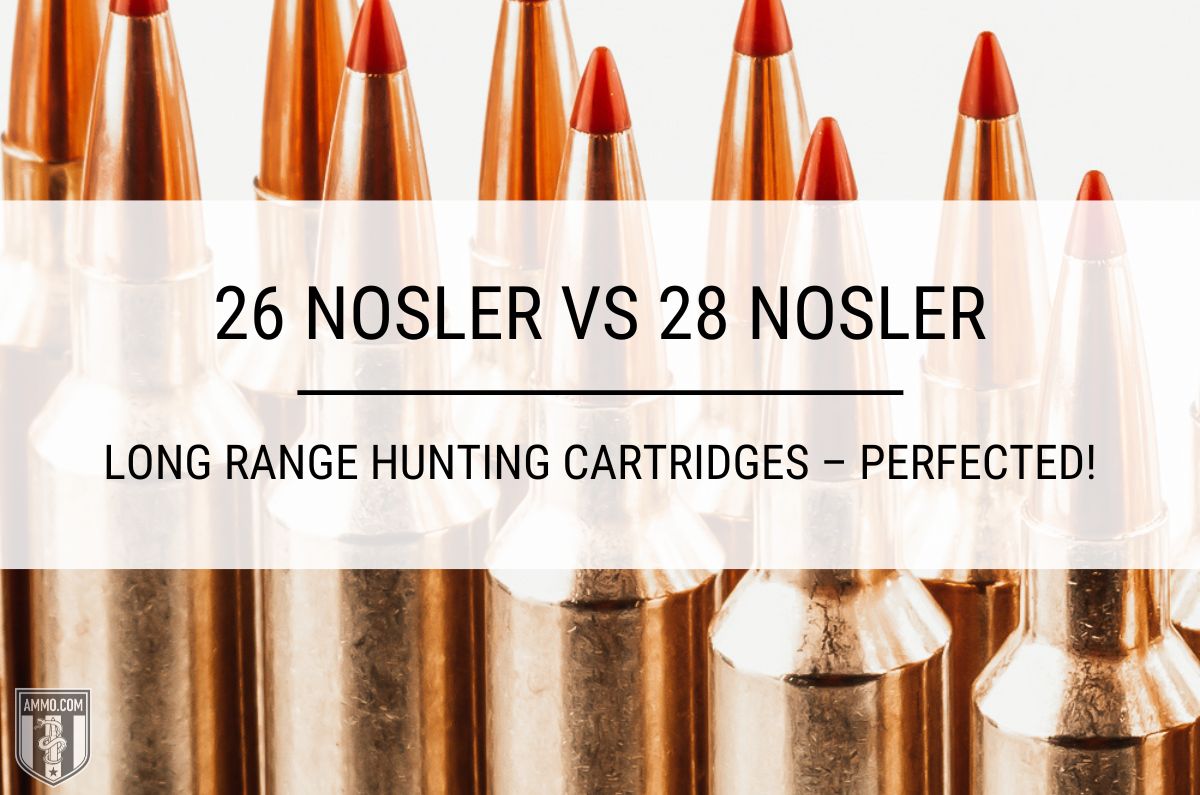
The 26 Nosler and 28 Nosler are the first two entries in the Nosler cartridge line that were specifically designed for long range shooting and big game hunting.
Both rounds were developed to push the edges of the performance envelope and give shooters an incredibly flat shooting, hard-hitting round that could dominate the great outdoors and the F-class firing line simultaneously.
The 26 and 28 Nosler are nearly identical in external dimensions as well as ballistic performance with the primary difference between the two being the caliber of bullet they fire. Both rounds are extremely effective at harvesting big game like elk and moose as well as being excellent options for 1,000-yard target shooting.
This leads many shooters to question which Nosler cartridge is superior - the 26 or 28?
In this article, we will evaluate the 26 Nosler vs 28 Nosler to help you understand the differences between the two and give you a clearer understanding of which cartridge is best for your shooting and big game hunting needs.
What is the difference between the 26 Nosler and the 28 Nosler?
The difference between the 26 Nosler and the 28 Nosler is the 26 Nosler fires a 6.5mm or 0.264” diameter bullet while the 28 Nosler fires a 7mm or 0.284” diameter bullet. This means the 28 Nosler can fire heavier bullets and has a slightly longer effective range than the 26 Nosler.
Cartridge Specs
When evaluating centerfire cartridges, it’s a good idea to analyze the cartridge specs to gain more knowledge of each.
The 26 Nosler was the first cartridge released by the company in 2013. Following the 26’s success, the 28 Nosler was released two years later in 2015.
At the time of writing, there are currently six Nosler cartridges available on the market listed below in order of their release:

- 26 Nosler (2013)
- 28 Nosler (2015)
- 30 Nosler (2016)
- 33 Nosler (2016)
- 22 Nosler (2017)
- 27 Nosler (2020)
The 26 Nosler was developed using the 300 Remington Ultra Magnum (RUM) as a parent case while the 28 Nosler was developed using a shortened and necked down 404 Jeffery case.
Although both rounds descended from different parent cartridges, they have virtually identical external dimensions as their case length (2.59”) and overall length (3.34”) are exactly the same.
The decision on a 3.34” overall length was driven by the desire for both rounds to fit into a standard-length action. A standard or long-action is the same used by the 30-06 Springfield and is lighter than a magnum action like those used by the 300 PRC, 7mm Remington Ultra Magnum, and 378 Weatherby Magnum.
Using a standard-length action means that the 26 and 28 Nosler will have a shorter bolt throw, allowing for faster follow-up shots, and be lighter than their magnum cartridge counterparts. Most sportsmen prefer a lightweight hunting rifle when venturing into heavy brush or on long stalks in the great outdoors.
Although the Nosler cartridges might fit into a standard action, they did not sacrifice anything in terms of stopping power as both cartridges have nearly identical case capacities. The 26 Nosler has a slightly higher capacity at 93.5 gr compared to 93 gr for the 28 Nosler.
For all intents and purposes, this difference is negligible, but it bears noting that you might be able to fit a small bit more powder in a 26 Nosler case if you are really pushing the muzzle velocity limits with your handloads.
To help simplify the manufacturing process, the 26 and 28 use a rebated rim design meaning their rim is narrower than their cartridge base. The rims on both rounds were narrowed to 0.534”, which is the same diameter as popular rounds like the 7mm Remington Magnum and 300 Win Mag.
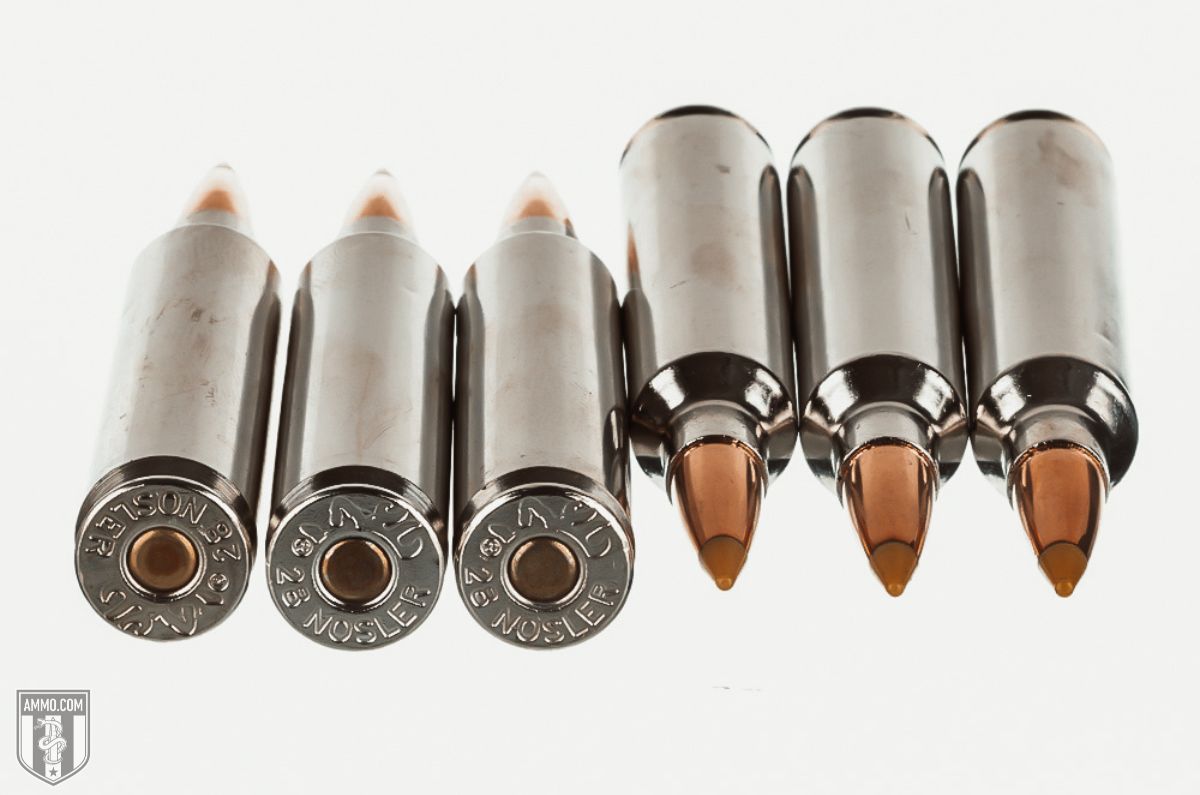
Both Nosler rounds have the same maximum chamber pressure of 65,000 psi per SAAMI specs.
Although the 26 and 28 Nosler are virtually identical, the one glaring difference between them is the bullet diameter each cartridge fires.
The 26 Nosler was developed to fire extremely flat shooting 6.5mm projectiles like those made popular by the 6.5 Creedmoor. The “26” in the cartridge name comes from the first two digits of the bullet diameter, 0.264”. In contrast, the 28 Nosler fires wider 7mm projectiles or 0.284” and utilizes the same naming convention.
Bullet weights for the 26 Nosler range between 120 and 150 grains while the 28 Nosler can fire bullets ranging between 150 to 175 grains.
However, with case capacity being essentially equal, do the heavier projectiles of the 28 Nosler create excessive recoil for shooters to endure?
Recoil
Recoil is an important consideration when purchasing a new rifle as a round with heavy recoil will be more difficult to control and will slow your rate of follow-up shots. The potential for flinching is also an issue for cartridges with heavy recoil.
Felt recoil will differ from shooter to shooter and is often dependent on firearm choice, stance, and your chosen factory ammo or handloads. However, free recoil is a more objective measure of how hard a cartridge hits based on firearm weight, muzzle velocity, powder charge, and bullet weight.
For this comparison we will analyze two popular rounds for long range hunting, the 175 gr Accubond Long Range traveling at 3,125 fps for 28 Nosler and the 150 gr Accubond Long Range traveling at 3,200 fps for 26 Nosler.
The firearm for this comparison will be the Nosler Model 48 Long Range Carbon Rifle weighing 7.75 lbs. As this rifle is available in both calibers, it will allow for a true apples-to-apples comparison.
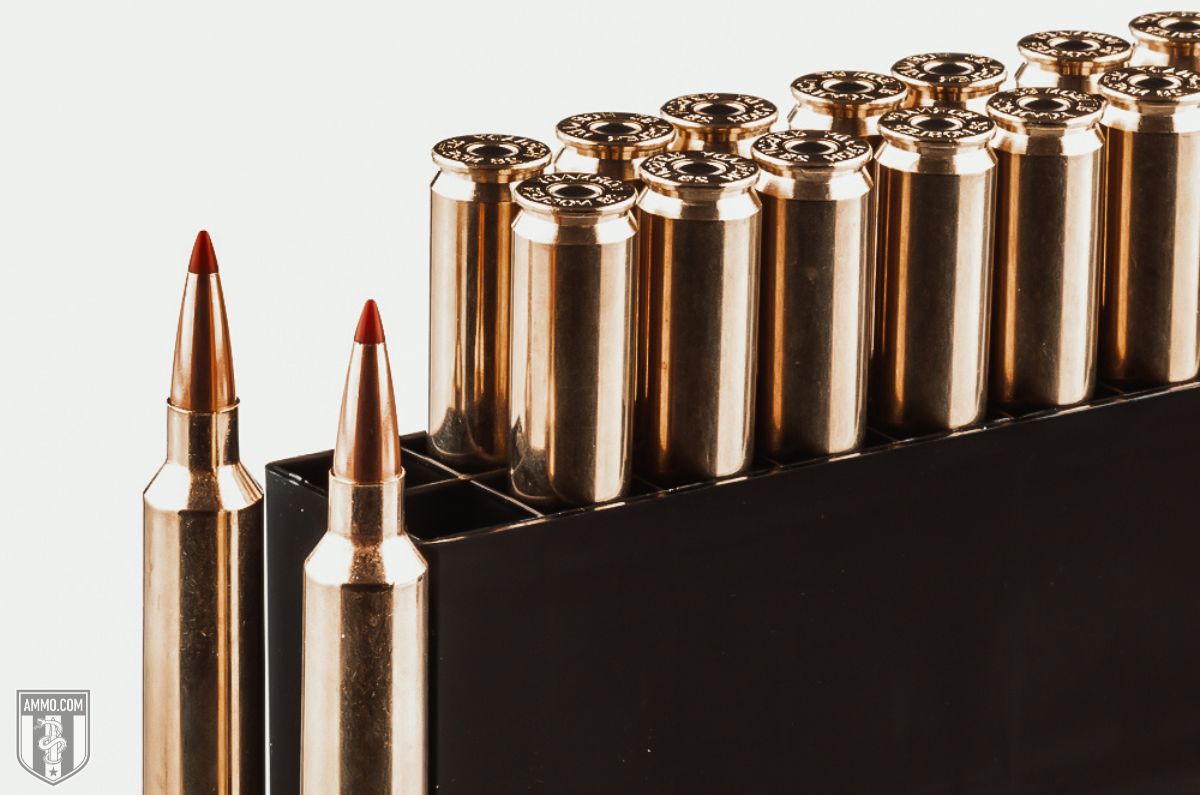
Given these loads, the 28 Nosler will have a free recoil of 39 foot-pounds of energy (ft-lbs) while the 26 Nosler will have 34 ft-lbs of free recoil.
This result is not entirely surprising, as the 26 Nosler fires slightly lighter bullets and has nearly equivalent powder charges, it makes sense that the 26 would have less recoil than the 28.
That being said, neither of these rifle cartridges would be considered low recoil and they are not the best cartridges to teach new or recoil sensitive shooters on.
Muzzle Velocity, Kinetic Energy, and Trajectory
One of the stated goals for Nosler’s new cartridges was to provide shooters with a flat shooting round that delivered superior ballistic performance compared to traditional long range shooting options.
Let’s evaluate Nosler’s claims by comparing four different factory loads for the 28 and 26 Nosler.
We selected the 140 gr Nosler Ballistic Tip and 150 gr Accubond Long Range for the 26 Nosler and the 162 gr Hornady ELD-X and 175 gr Nosler Accubond Long Range for the 28 Nosler.
Below is a ballistics table comparing the four selected rounds from 0-500 yards as well as at 800 yards to evaluate each round’s long range capabilities.
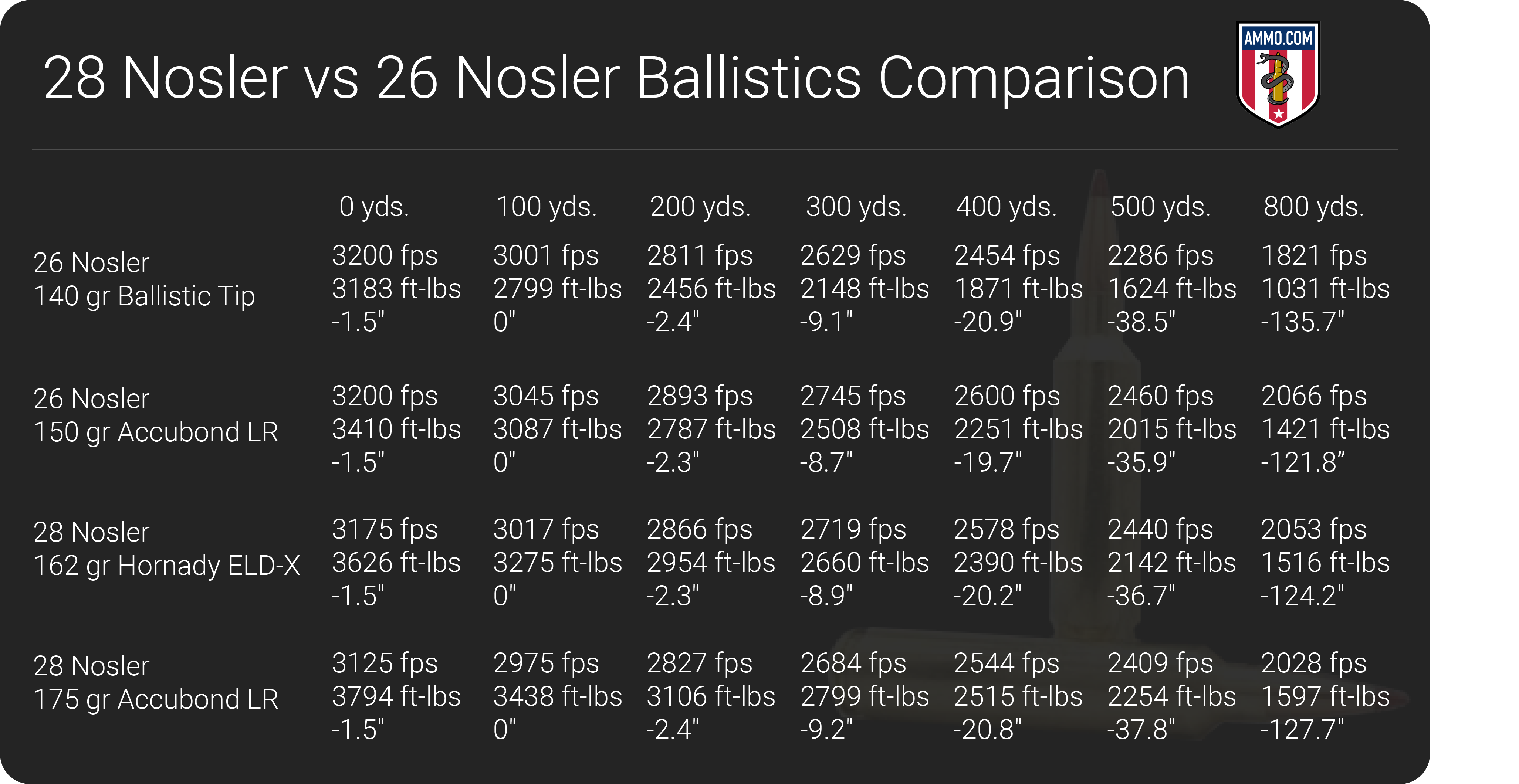
Looking at muzzle velocity, all four rounds were incredibly similar. Both 26 Nosler rounds had the highest muzzle velocity at 3,200 fps while the 28 Nosler rounds were slightly slower at 3,175 fps for the 162 gr ELD-X and 3,125 fps for the 175 gr Accubond.
This slight advantage in muzzle velocity is quite impressive considering the 28 Nosler is firing bullets that range between 10% and 15% heavier than the 26.
All four rounds had velocities above 2,000 fps at 800-yards save the 140 gr Nosler Ballistic Tip for the 26 that had slowed to 1,821 fps.
For muzzle energy, the 28 Nosler is clearly the superior option with its heavier bullets. The 175 gr Accubond claimed the highest muzzle energy at 3,794 ft-lbs while the 162 gr Hornady ELD-X was just barely behind at 3,626 foot-pounds of energy.
Not only are the muzzle energy values incredibly impressive, but all four rounds also excelled at conserving their kinetic energy at range as well. At 800 yards, all four factory loads had over 1,000 ft-lbs of energy, which is more than enough to take down a mule deer or whitetail at that distance.
The 26 and 28 Nosler were designed to be incredibly flat shooting, utilizing the most aerodynamic bullets available for their respective calibers. Both Nosler cartridges do not disappoint when it comes to trajectory, as they have less bullet drop than traditional long range rounds like the 300 Winchester Magnum, 6.5 Creedmoor, and 338 Lapua Magnum out to 800 yards.
The 150 gr Accubond Long Range for the 26 Nosler had the flattest trajectory at 800 yards with -121” of bullet drop, while both 28 Nosler options were close behind at -124” for the ELD-X and -127” for the 175 gr Accubond. The 140 gr Ballistic Tip had the most bullet drop at -135”.
Looking at the ballistic data as a whole, both the 26 and 28 Nosler sound like amazing cartridges with higher muzzle velocity, more kinetic energy, and flatter trajectories than most rounds on the market.
However, the price for these outstanding ballistics is paid in a shorter than normal barrel life.
Barrel Life
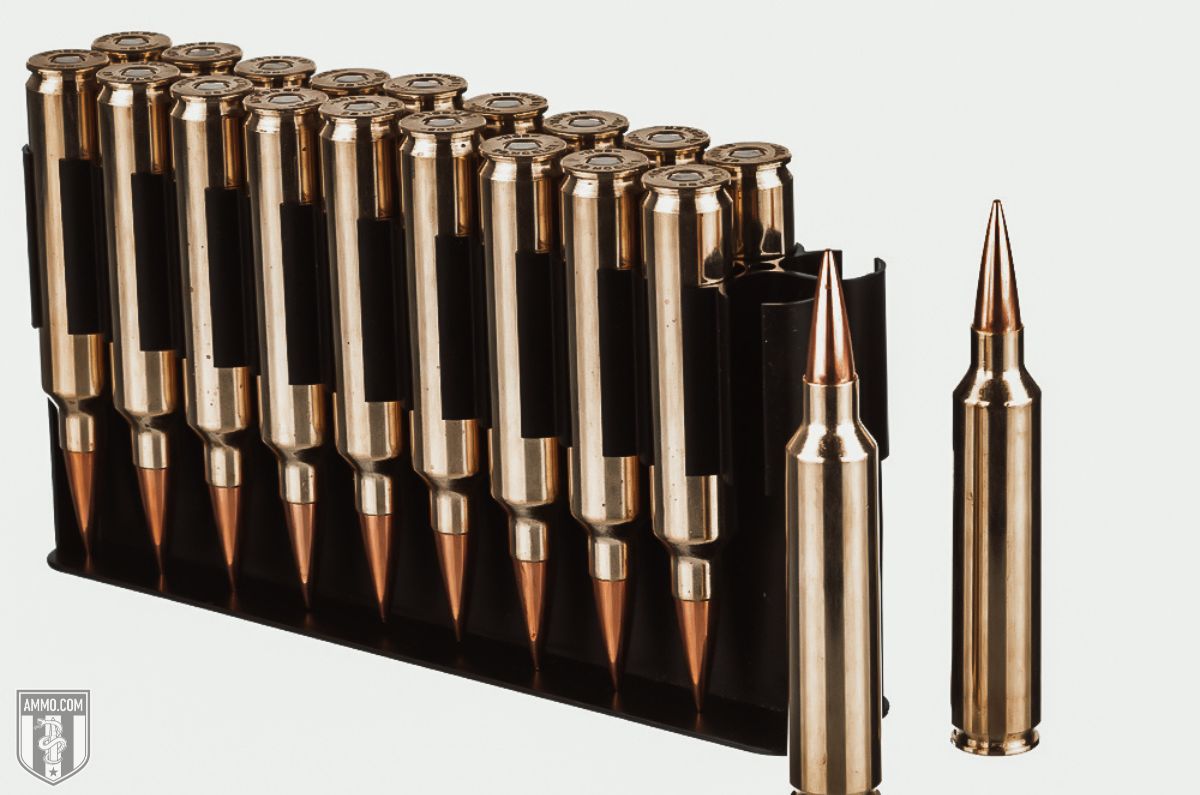
Perhaps one of the biggest critiques of the Nosler cartridges is their relatively shorter barrel life when compared to other long range shooting rounds.
When a cartridge is fired, the powder charge is ignited to push the bullet down the barrel. The resulting flame touches not only the base of the bullet but the rifling as well. Particularly vulnerable is the rifling at the mouth of the chamber.
Heat is the enemy of barrel life, the hotter you get your barrel the faster the rifling will begin to wear out.
It should be noted that most hunters will not “shoot out” a barrel for multiple seasons with either cartridge. Those who report short barrel life are typically high-volume competition shooters that are shooting near-maximum charge handloads to push the limits of muzzle velocity.
To increase your barrel’s lifespan, it’s best to run moderate pressure factory ammo or handloads below maximum charge. Furthermore, allowing the barrel to cool between strings of fire will also help extend your barrel life.
For a sub-MOA barrel, many shooters report a loss in peak accuracy for both rifle cartridges near 800-1000 rounds downrange, depending on how hot you handload them.
The main issue with the 26 and 28 is that they fire a considerably large powder charge into a relatively tight bore. This means that all the additional heat is focused on a smaller area which increases erosion of the rifling.
Handloaders can perform a technique called “chasing the lands” to help elongate the life of their barrels. As the lands of the barrel erode at the throat, a handloader can measure the levels of erosion and adjust their bullet seating depth to match it.
This helps maintain shot-to-shot consistency for a time, but it is a temporary fix as eventually, they will reach the limit of how far out they can seat their bullets.
The bottom line is that most hunters should not experience any appreciable difference in accuracy for multiple seasons, however, high-volume or competitive shooters will need to monitor the performance of their barrel closely.
Ballistic Coefficient and Sectional Density
Ballistic coefficient (BC) is a measure of how aerodynamic a bullet is and how well it will resist wind drift. Sectional density (SD) is a way to evaluate the penetration ability of a bullet based on its external dimensions, design, and weight.
One of the benefits of the 6.5mm and 7mm bullet design is their long, sleek profile which lends itself to having higher ballistic coefficients. A higher BC is preferred for long range shooting, as it means the bullet will be less affected by wind drift and air resistance.
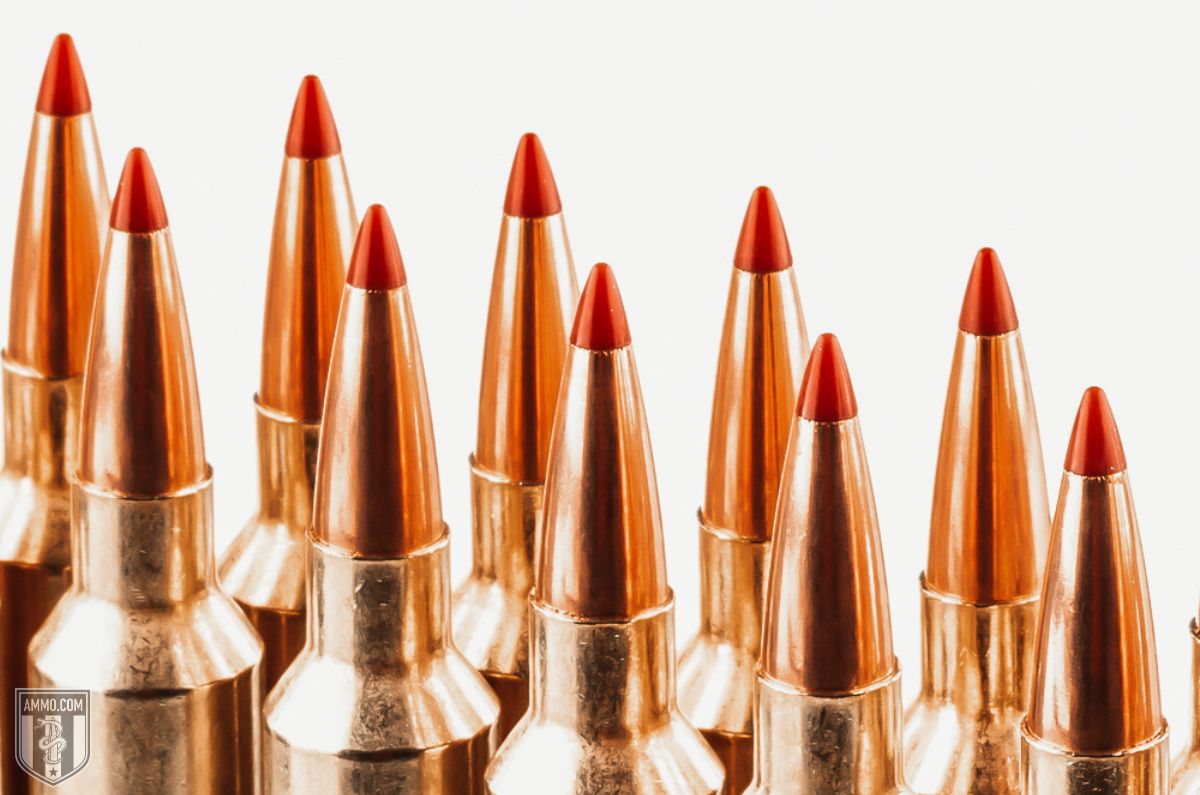
All the Nosler cartridges have very high BC values as they were designed around these aerodynamic bullets. From the cartridge selections in the ballistics section, the 140 gr Ballistic Tip ammo has a BC of 0.509 while the 150 gr Accubond has a BC of 0.634 for the 26 Nosler. On the other hand, the 175 gr Accubond has a BC of 0.648 and the Hornady ELD-X 162 grain bullet has a BC of 0.631 for 28 Nosler.
In general, 7mm bullets will typically have slightly higher BC values than 6.5mm bullets as the 7mm options are a little bit heavier. The extra weight helps fight against wind deflection as they are harder to move off course.
However, these Nosler cartridges are so close to one another, it is unlikely that shooters will see drastic differences in wind drift at typical hunting distances. Competitive shooters will notice these small BC variations at longer ranges (+1,000 yards), but the difference will be negligible for most shooters.
For sectional density, the 26 and 28 Nosler measure extremely high and have more than enough penetration for taking down big game animals like elk and moose. Typically, smaller diameter bullets will have a higher sectional density as they can focus all of their energy into a smaller area, thereby increasing penetration.
For the 28 Nosler, the 175 gr Accubond has a SD of 0.310 while the ELD-X measures 0.287. In contrast, the 140 gr Ballistic Tip has a SD of 0.287 while the 150 gr Accubond has a SD of 0.327 for 26 Nosler.
Although the 28 Nosler had a slight advantage in BC, the opposite is true for SD as the 26 Nosler has a slight edge. However, it is unlikely that any game animal that is hit with any of these rounds will be able to tell the difference, as the 26 and 28 offer more than enough penetration to reach the vital organs.
Hunting
The 28 and 26 Nosler are both excellent hunting cartridges capable of taking big game at long range.
Hunters often pose the question about which cartridge is better for big game hunting: 26 Nosler vs 28 Nosler?
As we’ve seen from the ballistic comparison, both rounds are extremely close to each other in terms of external and terminal ballistics. The 26 Nosler has a slightly flatter trajectory with a hint less recoil while the 28 Nosler offers a little more kinetic energy at range with a bit more recoil.
The 28 Nosler can maintain its kinetic energy at greater distances than the 26 Nosler, which gives it a bit more effective range for large game like elk.
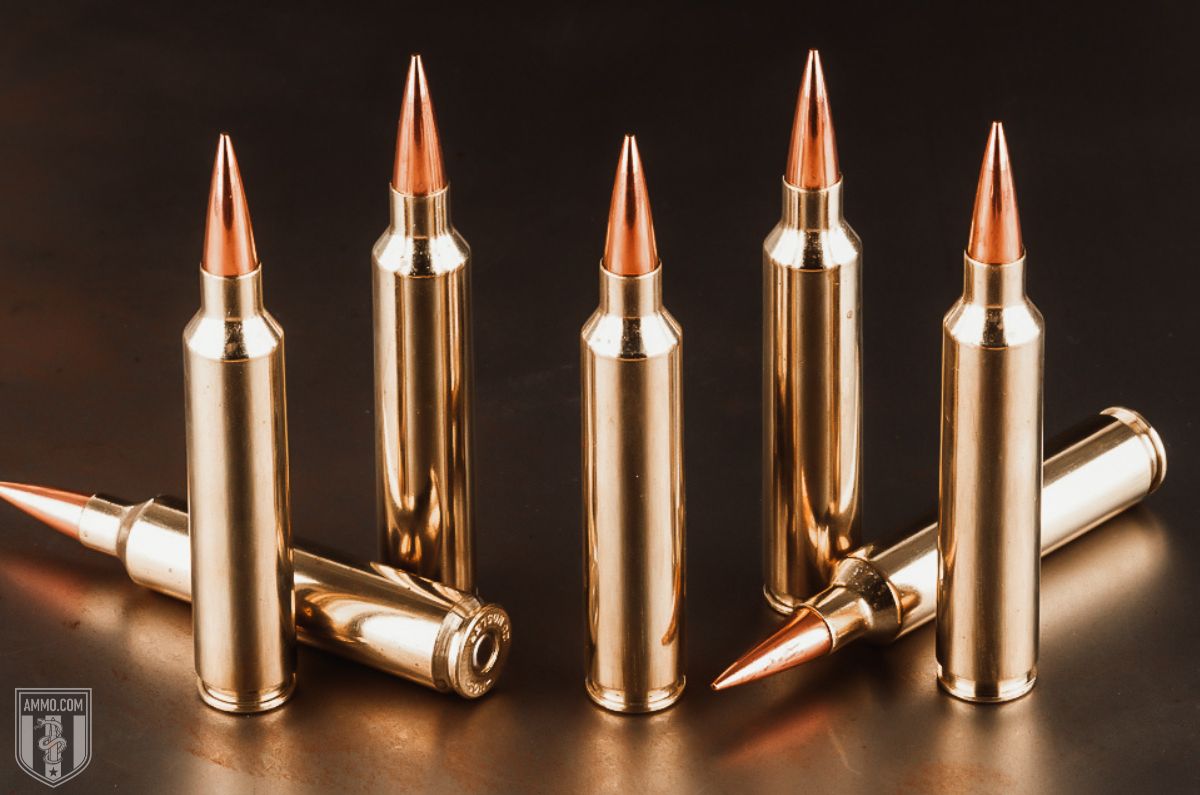
In the ballistics analysis, both 28 Nosler rounds maintained the recommended 1,500 ft-lbs of energy for ethically harvesting an elk at 800 yards while the 26 Nosler was below that number.
This is not to say that the 26 Nosler is ineffective against elk, on the contrary, it has harvested more than enough elk to prove its lethality. However, if you expect your shots to be over 600 yards then the 28 Nosler will give you the kinetic energy needed to reach those distances.
In terms of whitetail, mule deer, antelope, and pronghorn, both rounds are more than sufficient and proper loads can reach 1,000 yards with well over 1,000 ft-lbs of energy.
The bottom line is you cannot go wrong with either the 26 Nosler or 28 Nosler for big game. It more comes down to bullet selection and making sure that your factory ammo or handloads give you enough kinetic energy, bullet expansion, and penetration at the ranges you expect to shoot.
Ammo and Rifle Cost/Availability
Although the 26 was the new cartridge that spearheaded the Nosler line of ammo, the 28 Nosler has surpassed its predecessor in terms of ammo and rifle availability.
As both of these cartridges were built for long-range precision shooting, they are currently only available in bolt-action rifles.
In terms of rifle selection, there are only three options for the 26 Nosler: the Nosler Model 48, Christensen Arms Ridgeline, or Browning X-Bolt. On the other hand, the 28 Nosler is becoming more popular and multiple manufacturers like Savage, Bergara, and Seekins have factory rifles available in the caliber.
Custom rifles are available in both calibers, but these are prohibitively expensive for many shooters.
Ammo price and availability are also issues for both rounds, however, there are more options currently available for the 28 Nosler.
As the round has grown in popularity, the 28 Nosler is currently offered in multiple configurations from Nosler, Browning, and Hornady. On the other hand, Nosler is currently the only ammo manufacturer offering factory loads in 26 Nosler.
In terms of price, both the 26 and 28 are essentially equal in terms of cost per round. At the time of writing, inexpensive ballistic tip ammo costs nearly $3/round while premium hunting or match ammo will run closer to $6/round.
Reloading

Reloading is one method shooters use to reduce their overall cost per round and increase the consistency and accuracy of their ammo to sub-MOA levels. Furthermore, handloads can be tailored to your rifle to meet your specific shooting needs.
Sourcing brass can be a bit tricky for both cartridges, as Nosler, Norma, and Hornady are currently the only manufacturers of factory-new brass.
Bullet options are relatively plentiful as both 6.5 and 7mm bullets are popular in the shooting community. The 26 Nosler shares bullet compatibility with the 6.5 Creedmoor, 260 Remington, 6.5 Grendel, 6.5 Swiss, and 264 Winchester Magnum. The 28 Nosler fires the same bullet diameter as the 7mm Rem Mag, 7 WSM, 7mm Weatherby Magnum, and 7mm Mauser just to name a few.
All the major bullet manufacturers like Barnes, Hornady, Nosler, Norma, Berger, and Sierra offer bullets for 0.264” and 0.284” caliber.
In terms of load data, Nosler and other manufacturers like Hodgdon have multiple loading options for both cartridges with a wide variety of powder options. Furthermore, both cartridges use the less utilized large rifle magnum primer. This means that you might be able to source primers even during shortages, as large rifle magnum primers are not used as frequently as small rifle or large rifle primers.
The largest issue with reloading for the 26 or 28 will be finding brass cases for reloading. We recommend saving your brass when shooting factory ammo or you could possibly find some once-fired brass on the secondary market.
Final Shots: 28 Nosler vs 26 Nosler
The 26 Nosler and 28 Nosler are two precision rifle cartridges that epitomize the evolution of modern ammunition technology.
Each round was purposefully built to maximize the potential of their respective caliber and are highly regarded in long range competitive shooting and big game hunting circles.
The 26 Nosler and 28 Noser offer shooters an incredibly flat trajectory with bone-crushing terminal ballistics that can take down virtually any game animal North America has to offer at standoff distances.
The 28 Nosler has become slightly favored for big game hunting, as the heavier bullets it can fire are highly regarded by hunters and long-range shooters alike. However, with proper load and bullet selection, there’s not much that the 28 Nosler can do that the 26 Nosler can’t.
The bottom line is that you can’t go wrong with either cartridge, however, our recommendation is the 28 Nosler as it is slightly easier to source ammo and rifles for as well as hitting just a little bit harder than the 26 Nosler.
No matter which cartridge you choose, make sure you stock up on ammunition here at Ammo.com and I’ll see you on the range!
Ammo Comparisons
- .308 vs 5.56
- 6.5 Creedmoor vs .308
- .300 Blackout vs .308
- .300 Win Mag vs .308
- .243 vs .308
- .308 vs .30-06
- 7mm-08 vs .308
- .270 vs .308
- 7.62x39 vs .308
- .223 vs .308
- .338 Lapua vs .308
- .380 ACP vs 9mm
- .223 vs 5.56
- .300 Blackout vs 5.56
- 9mm vs 45 ACP
- 9mm vs 40 S&W
- .357 SIG vs 9mm
- 10mm vs 9mm
- 9mm vs 9mm Luger
- .243 vs .270
- .300 Win Mag vs .30-06
- .270 vs .30-06
- .40 vs .45
- 38 Special vs 357
- 9mm vs 40 vs 45
- 5.56 vs 7.62x39
- 338 Lapua vs .30-06
- .30-30 vs .30-06
- 300 PRC vs 338 Lapua
- .30-06 vs 7mm
- 300 Win Mag vs 338 Lapua
- 300 PRC vs 300 Win Mag
- 300 WSM vs 300 Win Mag
- 338 Win Mag vs 338 Lapua
- 12 Gauge vs 20 Gauge
- 10mm vs 357 Mag
- .30-30 vs 7.62x39
- 224 Valkyrie vs 22-250
- 17 HMR vs 22 Mag
- 7.62x39 vs .300 Blackout
- 45 ACP vs 45 Auto
- 45-70 vs 30-30
- 300 Blackout vs 223
- 357 Magnum vs 9mm
- 350 Legend vs 300 Blackout
- 224 Valkyrie vs 223
- 45 ACP vs 38 Super
- 6.5 Grendel vs .308
- 17 HMR vs 22 LR
- 10 Gauge vs 12 Gauge
- 22-250 vs 223
- 45 Colt vs 45 ACP
- 350 Legend vs 30-30
- 5.7x28 vs 223
- 5.7 vs 9mm
- 5.56 vs 5.7
- 22 vs 9mm
- Buckshot vs Birdshot
- 450 Bushmaster vs 308
- 450 Bushmaster vs 223
- Buckshot vs Slug
- 6.5 Grendel vs 5.56 vs 223
- 6mm ARC vs 6.5 Grendel
- 44 vs 45
- 458 SOCOM vs 5.56
- 357 vs 44
- 32 ACP vs 380
- 300 Win Mag vs 338 Win Mag vs 338 Lapua Mag
- 450 Bushmaster vs 458 SOCOM vs 50 Beowulf
- 6mm Creedmoor vs 6.5 Creedmoor
- TMJ vs FMJ
- 44 Special Vs 44 Magnum
- 45 90 vs 45 70
- 6.8 Western vs 6.8 SPC
- 50 Beowulf vs 50 BMG
- 26 Nosler vs 6.5 PRC
- 28 Gauge vs 410
- 6.8 SPC vs 5.56
- 6.8 SPC vs 6.5 Grendel
- 6.8 Western vs 7mm Rem Mag vs .28 Nosler
- 6.8 Western vs 6.5 Creedmoor
- 22 Hornet vs 223
- 6.8 Western vs 6.5 PRC
- .410 vs 12 Gauge
- .410 vs 20 Gauge
- 22 LR vs 22 Mag
- 6mm ARC vs 243
- 7mm-08 vs 270
- 243 vs 6.5 Creedmoor
- Nickel vs Brass Casing
- 204 Ruger vs 223
- 50 Beowulf vs 5.56
- 260 Remington vs 6.5 Creedmoor
- 6mm Remington vs 243
- 28 Nosler vs 300 PRC
- 50 Beowulf vs 50 AE
- 22 Nosler vs 22-250
- 450 Marlin vs 45-70
- 300 Win Mag vs 300 Norma
- 458 SOCOM vs 300 Blackout
- 38-55 vs 45-70
- 22 Hornet vs 22 LR
- 300 Norma vs 338 Lapua
- 338 Lapua vs 50 BMG
- 28 Nosler vs 300 Win Mag
- 28 Nosler vs 6.5 Creedmoor
- 204 vs 22-250
- 458 SOCOM vs 45 70
- 44 40 vs 45 70
- 6.8 SPC vs 6.5 Creedmoor
- 450 Bushmaster vs 30-06
- 7mm Rem Mag vs 300 Win Mag
- 30 Carbine vs 223
- 25-06 vs 30-06
- 26 Nosler vs 28 Nosler
- 16ga vs 12ga
- 30 06 vs 7.62 x54R
- 9mm Makarov vs 9mm Luger
- 350 Legend vs 223
- 30 Carbine vs 5.56
- 6.5x55 vs 6.5 Creedmoor
- 6.5 Creedmoor vs 270 vs 25-06
- M193 vs M855
- 450 Bushmaster vs 458 SOCOM
- 6.5 Grendel vs 6.5 Creedmoor
- 350 Legend vs 5.56
- .277 Fury vs 6.8 SPC
- 277 Fury vs 300 Win Mag
- 10mm vs .45 ACP
- 277 Fury vs 223
- 6.8 SPC vs 300 Blackout
- 6.5 PRC vs 6.5 Creedmoor
- 277 Fury vs 308
- 277 Fury vs 6.5 Creedmoor
- 350 Legend vs 450 Bushmaster
- 277 Fury Vs 5.56 NATO
- 10mm vs 40S&W
- 32 ACP vs 9mm
- 32 Special vs 9mm
- 8.6 Blackout vs 300 Blackout
- 30 Super Carry vs. 9mm
- 5.56 vs 9mm
- .50 Action Express vs 9mm
- 7.62x25 vs. 9mm
- 10mm vs 44 Magnum
- 300 Blackout vs 300 Win Mag
- 6.5 Grendel vs 300 Blackout
- 460 Rowland vs 10mm
- 300 RUM vs 300 PRC
- 300 Norma vs 300 PRC
- 45 GAP vs 45 ACP
- 7mm PRC vs 300 Win Mag
- 300 PRC vs 6.5 Creedmoor
- 300 PRC vs 308
- 357 SIG vs 357 Mag
- 7.62x39 vs 7.62x51
- 243 Win vs 223 Rem
- 30 Nosler vs 300 PRC
- 6.5 Creedmoor vs. 30-06 Springfield
- 450 S&W vs. 44 Magnum
- 6.5 Creedmoor vs. 300 Win Mag
- 454 Cassull vs. 45-70 Govt
- 454 Cassull vs. 44 Mag
- 7.62x54r vs. 308 Winchester
- 22 ARC vs. 223 Rem
- Subsonic vs. Supersonic Ammo
